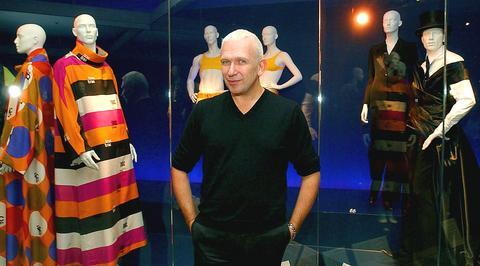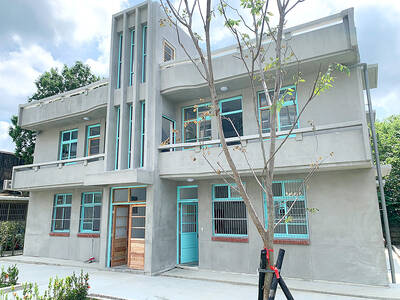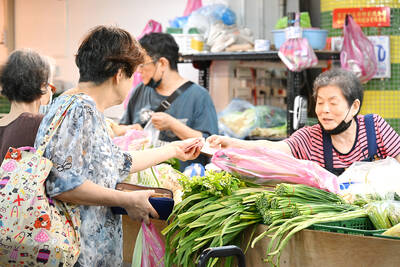Slices of fresh bread overlap to form the cascading train of an evening gown. Baguettes sprout like a skirt from a wicker basket in the shape of a corset, where two brioches perch like women's breasts.
The mouth-watering creations are just two of the outfits on show in the exhibition Pain Couture by Jean-Paul Gaultier, in which the irreverent French designer has conjured a surrealist wardrobe made entirely from bread.

PHOTO: EPA
Layers of puff pastry are delicately toasted in the shape of a folded umbrella. The conical bra top which Gaultier designed for pop icon Madonna is rendered in intricately patterned dough, baked to golden perfection.

PHOTO: EPA
Visitors to the show at the Fondation Cartier in Paris can even take home a designer croissant ringed with blue stripes -- a nod to Gaultier's trademark seaman's jersey.
The humor is characteristic of the former "enfant terrible" of French fashion, crowned king of Paris couture for his daring clothes that cross genders and blend ethnic influences.

PHOTO: EPA
"When the Fondation Cartier contacted me, they wanted me to show clothes, but I don't think it's up to me and I don't find this kind of tribute appropriate for a living designer," Gaultier said in an interview conducted via e-mail.
"In addition, the Fondation is a place devoted to art and I absolutely don't consider myself an artist. With this exhibition, I wanted to show I am above all an artisan, and fashion is a craft, so I decided to put my trade on a level with bakery," he added.
EXPLODING DOLLS
Taming the dough was one of the challenges faced by the team of top bakers -- including members of France's national baking team -- enlisted by Gaultier to make his vision come true.
He insisted they use leavened dough rather than the yeast-free mix normally favored for decorative baking, in order to obtain pieces that looked like fresh bread. There were a couple of mishaps along the way.
"Initially his team sent us a dressmaker's doll and so we started by coating it with dough, stuck it in the oven and everything exploded of course," baker Jacques Souilhat said.
"So we realized we needed a stiff mould that would withstand the temperature of the oven and they made us plaster casts."
Through trial and error, the team succeeded in producing technical marvels such as a solid bread kilt and a swinging short dress consisting of rows of wafer-thin biscuits.
The loaves of bread have been gutted of their dough to prevent them from rotting, but there is still a risk some creations will implode as they dry out over the course of the show, scheduled to run until Oct. 10.
A fully functioning bakery in the basement of the museum not only churns out fragrant fresh bread for sale but will also be on standby to replace any damaged exhibits.
Surrounding the ovens are giant black-and-white photographs, including a timeless shot of a model in a skin-tight laced corset dress reaching for a loaf of bread.
The picture potently reunites two of France's greatest exports -- fashion and gastronomy. For Gaultier, good cooking is like a beautiful dress.
"The two are ephemeral, must give pleasure and are sometimes the result of a lot of hard work, but this should not be apparent," he said.
humble bread
In many ways, producing a humble loaf of bread is no different from making an exquisite haute couture dress. Both professions use obscure jargon and rest on specialized skills handed down from generation to generation.
"The two trades have a lot in common, a lot of gray matter and hard graft. The material is different -- fabric and dough -- but my work with the bakers resembles my collaboration with the couture workshops," Gaultier said.
Baker Thierry Meunier said he was initially wary of working with fashion insiders because of their reputation for flamboyance, but he was surprised to find how much they had in common.
"The most blatant similarity is the pressure of working to deadlines, because bakers like designers have to be very quick and capable of working in long stretches at the last minute to deliver their product," he said.
Souilhat, meanwhile, pointed out that an artistic streak is vital to making good bread.
"Is dough not lace, are the folds of croissant pastry not like layers of petticoats? And the touch of the dough -- now that really is like skin," he said with a dreamy smile.

June 2 to June 8 Taiwan’s woodcutters believe that if they see even one speck of red in their cooked rice, no matter how small, an accident is going to happen. Peng Chin-tian (彭錦田) swears that this has proven to be true at every stop during his decades-long career in the logging industry. Along with mining, timber harvesting was once considered the most dangerous profession in Taiwan. Not only were mishaps common during all stages of processing, it was difficult to transport the injured to get medical treatment. Many died during the arduous journey. Peng recounts some of his accidents in

“Why does Taiwan identity decline?”a group of researchers lead by University of Nevada political scientist Austin Wang (王宏恩) asked in a recent paper. After all, it is not difficult to explain the rise in Taiwanese identity after the early 1990s. But no model predicted its decline during the 2016-2018 period, they say. After testing various alternative explanations, Wang et al argue that the fall-off in Taiwanese identity during that period is related to voter hedging based on the performance of the Democratic Progressive Party (DPP). Since the DPP is perceived as the guardian of Taiwan identity, when it performs well,

The Taiwan People’s Party (TPP) on May 18 held a rally in Taichung to mark the anniversary of President William Lai’s (賴清德) inauguration on May 20. The title of the rally could be loosely translated to “May 18 recall fraudulent goods” (518退貨ㄌㄨㄚˋ!). Unlike in English, where the terms are the same, “recall” (退貨) in this context refers to product recalls due to damaged, defective or fraudulent merchandise, not the political recalls (罷免) currently dominating the headlines. I attended the rally to determine if the impression was correct that the TPP under party Chairman Huang Kuo-Chang (黃國昌) had little of a

A short walk beneath the dense Amazon canopy, the forest abruptly opens up. Fallen logs are rotting, the trees grow sparser and the temperature rises in places sunlight hits the ground. This is what 24 years of severe drought looks like in the world’s largest rainforest. But this patch of degraded forest, about the size of a soccer field, is a scientific experiment. Launched in 2000 by Brazilian and British scientists, Esecaflor — short for “Forest Drought Study Project” in Portuguese — set out to simulate a future in which the changing climate could deplete the Amazon of rainfall. It is